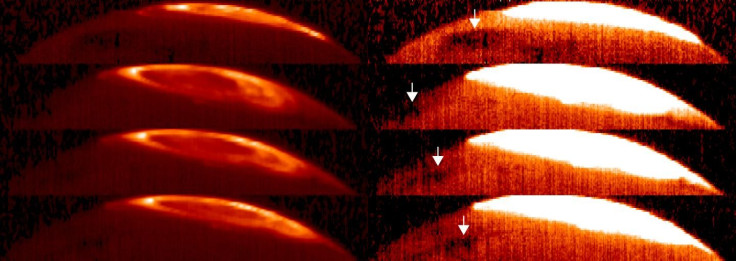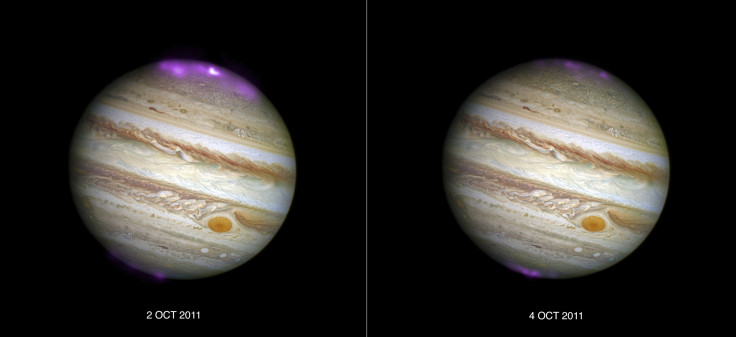Jupiter, Known For Its Great Red Spot, Has A Great 'Cold' Spot Too

Humankind has been obsessed with Jupiter — the largest planet in our solar system — since Galileo first saw it through a telescope and discovered a truly alien planet bedecked with swirling bands. In the 400 years since, scientists have uncovered several secrets about this gas giant, but, as each new discovery reveals, we are only just scratching the surface (quite literally).
The most famous feature on Jupiter, of course, is the Great Red Spot — a persistent and gigantic storm that has been rumbling in the gas giant’s southern hemisphere for at least the past 300 Earth years. Now, a team of astronomers, using the CRIRES instrument on the European Southern Observatory’s Very Large Telescope (VLT), has spotted another massive weather system in the planet’s atmosphere — one they call the “Great Cold Spot.”
Read: Jupiter's Great Red Spot, Turbulent Atmosphere Revealed In New Hubble Image
Measuring about 15,000 miles in longitude and roughly 7,500 miles in latitude, this localized dark spot is comparable in size to the Great Red Spot. However, the Great Cold Spot is located much higher in the gas giant’s atmosphere, in a region of the thermosphere that is around 200 Kelvin (360 degrees Fahrenheit) cooler than the surrounding atmosphere, which can range in temperature between 700K and 1,000K.
“This is the first time any weather feature in Jupiter's upper atmosphere has been observed away from the planet's bright aurorae,” Tom Stallard, an associate professor of planetary astronomy at the University of Leicester, and lead author of a study detailing the observations, said in a statement released Tuesday. “The Great Cold Spot is much more volatile than the slowly changing Great Red Spot, changing dramatically in shape and size over only a few days and weeks, but it has re-appeared for as long as we have data to search for it, for over 15 years. That suggests that it continually reforms itself, and as a result it might be as old as the aurorae that form it - perhaps many thousands of years old.”
Terrestrial aurorae are produced when charged particles, known as coronal mass ejections (CMEs), enter Earth’s magnetosphere — a region of space formed by the interaction between stellar winds and the planet’s magnetic field. Once within the magnetosphere, Earth’s magnetic field lines direct the charged particles toward the poles, where they collide with gas atoms in the atmosphere and produce the bright emissions associated with aurorae. Oxygen, for instance, produces the green colors in an aurora while nitrogen causes blue or red colors.
On Jupiter, solar winds carrying the CMEs compress its magnetosphere, shifting its boundary inward by more than a million miles. This gives rise to energetic X-rays in Jupiter’s aurorae, which cover an area bigger than the surface of Earth.

According to the researchers, the Great Cold Spot may be the byproduct of these aurorae, which drive energy into the atmosphere in the form of heat flowing around the planet. This phenomenon could be creating a region in the thermosphere that is colder than the surroundings.
Read: Solar Storms Trigger Gigantic X-Ray Aurorae On Jupiter
“Observations and modelling of Earth's upper atmosphere have shown that, on the short term, there may be changes in the temperature and density of the upper atmosphere,” Stallard said. “The two main differences are firstly that Earth's aurora sees dramatic changes caused by activity from the Sun, whereas Jupiter's aurora are dominated by gases from the volcanic moon Io, which are relatively slow and steady, and secondly that the atmospheric flows generated by Earth's aurora can drive heat quickly across the whole planet, making the upper atmosphere ring like a bell, while Jupiter's fast spin traps this energy nearer the poles.”
The discovery of this structure in Jupiter opens up the possibility such aurora-generated weather systems may exist on other planets. Scientists hope that further observations using the Juno spacecraft, which is currently orbiting the gas giant, would help them better understand how this cold weather system formed and is being sustained.
© Copyright IBTimes 2025. All rights reserved.






















